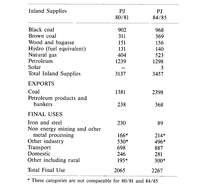


Chapter 11
I The Present Energy Economy
II Australian Energy Consumption
III Research And Development
IV Coal
V Oil And Natural Gas
VI Solar Energy
VII Nuclear Energy
VIII Bagasse Firewood And Other Biomass
IX Electric Power Generation And Distribution electric Power Generation And Distribution
X Manufactured Gas
XI Industrial Process Heat
Sources
Index
Search
Help
Contact us

Energy exports, mostly black coal, are also shown at the bottom of the chart and illustrate the way Australia has become a net energy exporting country since the development of the oil and gas fields of the Northwest Shelf and Bass Strait in the late 1960s and early 1970s.
The end use pattern is interesting in that it shows how dependent we are on petrol, oil and natural gas compared with electricity and coal. Since 1980 the pattern and the quantities have changed a little, as can be seen in Table 1.

Source for 84/85 data Department of Resources and Energy
Solar energy does not appear on the chart, but is listed in the Table. It could appear as a line from left to right ending in Domestic usage. In 1987 solar water heaters provided about 1 per cent of domestic energy. This excludes windmills, solar salt production, clothes drying, and its passive use in homes, where the sun shines through windows in winter and is excluded by shades in summer.
Although coal is the nation's largest energy resource and also its largest earner of foreign currency, oil is the biggest component of end-use energy and directly serves transport, industry and homes. For many years the economy was almost entirely dependent on imports for this vital commodity, so it is not surprising that the discovery of large oil fields in Australia was enthusiastically welcomed by all sections of the community. By the early 1970s, two-thirds of the country's needs were being met from local sources.
 |
Australian Academy of Technological Sciences and Engineering |  |
© 1988 Print Edition page 781, Online Edition 2000
Published by Australian Science and Technology Heritage Centre, using the Web Academic Resource Publisher
http://www.austehc.unimelb.edu.au/tia/752.html